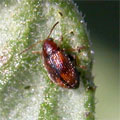VARIETIES DEVELOPED
Grape VARIETIES
1. Bangalore Blue:
A variety local to the surroundings of Bangalore (Karnataka).
Possibly, a vinifera x
labrusca hybrid, it is a heavy bearer and produces two crops in a
year. Medium vigoured vines produce bunches that are small and
compact. Berries are dark blackish - purple, seeded, small to medium
in size, spherical with thick skin that separates easily from the
pulp. Pulp is pale green coloured, TSS ranges from 18-20°B and
titrable acidity is around 0.8 to 0.9 per cent. It is tolerant to
anthracnose disease, but susceptible to rust.
2. Anab-e-Shahi:
A popular variety of Andhra Pradesh and Karnataka. Vines very heavy
yielding and vigorous. Bunches are very large, slightly shouldered or
conical in shape and well filled. Berries are late maturing, seeded,
large to very large in size, oval, pale green to amber colored, low
in total soluble solids (16-18°B) and titrable acidity is around 0.45
to 0.58 per cent..
3.
Dilkush:
It
is a mutant of Anab-e-Shahi, which produces elongated golden yellow
coloured berries. The area under this variety is increasing in recent
years in place of Anab-e-shahi as it fetches premium price in market
for its elongated berries.
4.
Thompson
Seedless:
(Syn. Kishmish, Bedana, Sulthana): This is the most popular and
commercially exploited variety in the world. In India it occupies
more than 70% area of grape cultivation for both table and raisin
purpose. Vines are vigorous, medium cropper, bunches small to medium
in size, conical to cylindrical in shape, well filled and sometimes
may be compact and hence needs chemical and mechanical berry
thinning. Berries are seedless; ellipsoidal, pale green to amber
coloured and of good quality with crisp pulp and T.S.S. around 22°B.
It requires about 130-150 days for ripening and continues to ripen in
warmer seasons also. The majority of exported grapes from India
consist of this variety. Tas-A-Ganesh and Sonaka are
the clones of this variety which are commercially cultivated in
Maharashtra and Karnataka states and they respond well to GA3
application.
5.
Gulabi:
(Syn. Karachi,
Pannerdrakshi, Muscat): Mostly grown in Tamil Nadu. A. seeded
cultivar, medium vigour, medium to heavy yielder. Bunches are medium
in size and loosely filled.
Berries are coloured, small, muscat flavoured, early maturing
spherical with thick skin and have moderate keeping quality. T.S.S.
is around 20°B, but has a problem of uneven ripening of berries.
6.
Flame Seedless:
It is an early variety, producing medium to small sized berries that
are seedless, firm skinned and tender fleshed. It has a mild,
sweet/tart flavour and when ripe, it turns to dark flame, rust red
colour. Vines are vigorous, self-fruitful and are heavy bearers.
Bunches are medium to large, conical and well filled. It is very
early ripening variety and requires about 95-110 days for ripening
after pruning. Ripening should coincide with cool climate for uniform
colour.
7.
Red Globe:
It is less to medium vigorous variety. Bunches are large, conical and
well filled. Berries are tan-red, very large, round and seeded. They
have crisp fleshy pulp, and a neutral flavour. It has good keeping
quality with plump berries well attached to the stems. It is late
ripening variety and takes more than 140 days from pruning to ripen.
Its cultivation is becoming popular in southern Interior Karnataka
(around Bengaluru and adjoining districts) because of mild tropical
climatic conditions suitable for obtaining good colour during fruit
ripening. It has good keeping quality and can be cold stored for at
least 3 months. Fruit yield is about 20-25 tons per hectare.
8.
Sharad Seedless:
A variety introduced from Russia, where it is popularly known as
Kishmish chorni. It has become a highly accepted cultivar in western
and southern India in recent years. Berries black and seedless, with
crispy pulp and are very sweet (T.S.S. is around 22°B). It is medium
duration variety which requires about 125-130 days for ripening. In
recent years, some of the clonal selections made from this variety
are gaining popularity and replacing the area under Sharad Seedless
cultivation. Among several clones, Krishna Seedless and
Jumbo Seedless are the clonal selections from this
variety that produce elongated large sized berries and respond well
to GA3 application. These varieties are becoming very
popular in southern interior Karnataka regions because it’s cooler
climate during fruit ripening which favours uniform colour
development.
9.
Fantasy
Seedless:
Vines are very vigorous and requires high sunlight for adequate
fruitfulness. This variety doesn’t require GA3 for thinning and
sizing. Berries are medium bold, deep purple to black, seedless, thin
skin and firm and obvate in shape. Clusters are medium in size,
conical shape, and medium to loose with respect to cluster
compactness. It is a mid to late ripening variety. This variety is
susceptible for berry cracking. Hence, care must to be taken to
manage irrigation and diseases particularly powdery mildew at the
time of fruit ripening.


